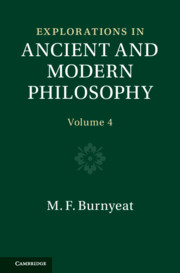Book contents
- Explorations in Ancient and Modern Philosophy
- Explorations in Ancient and Modern Philosophy
- Copyright page
- Contents
- Illustrations
- Preface
- Acknowledgements
- Abbreviations
- Introduction
- Part I Ontology and epistemology
- Chapter 1a Apology 30b2–4: Socrates, money, and the grammar of γίγνεσθαι
- Chapter 1b On the source of Burnet’s construal of Apology 30b2–4: a correction
- Chapter 2 Plato on how not to speak of what is not: Euthydemus 283a–288a
- Chapter 3 Platonism in the Bible: Numenius of Apamea on Exodus and eternity
- Chapter 4 Kinēsis vs. energeia: a much-read passage in (but not of) Aristotle’s Metaphysics
- Chapter 5 De Anima ii.5
- Chapter 6 Aquinas on ‘spiritual change’ in perception
- Chapter 7 Epistēmē
- Part II Physics and optics
- Bibliography
- Index locorum
Chapter 6 - Aquinas on ‘spiritual change’ in perception
from Part I - Ontology and epistemology
Published online by Cambridge University Press: 24 March 2022
- Explorations in Ancient and Modern Philosophy
- Explorations in Ancient and Modern Philosophy
- Copyright page
- Contents
- Illustrations
- Preface
- Acknowledgements
- Abbreviations
- Introduction
- Part I Ontology and epistemology
- Chapter 1a Apology 30b2–4: Socrates, money, and the grammar of γίγνεσθαι
- Chapter 1b On the source of Burnet’s construal of Apology 30b2–4: a correction
- Chapter 2 Plato on how not to speak of what is not: Euthydemus 283a–288a
- Chapter 3 Platonism in the Bible: Numenius of Apamea on Exodus and eternity
- Chapter 4 Kinēsis vs. energeia: a much-read passage in (but not of) Aristotle’s Metaphysics
- Chapter 5 De Anima ii.5
- Chapter 6 Aquinas on ‘spiritual change’ in perception
- Chapter 7 Epistēmē
- Part II Physics and optics
- Bibliography
- Index locorum
Summary
What does Aquinas mean when he speaks of ‘spiritual’ change in explaining sense perception? This chapter is partly exegesis of that notion, partly explication of the author’s own previous invocation of ‘spiritual’ change to characterise the way perception for Aristotle takes on sensible form without matter, and partly explanation of why in philosophy since Descartes it is so difficult to understand how for Aristotle and Aquinas perception is both physical and mental. For both thinkers, it is an ‘unordinary’ physical alteration. That does not make it a ‘mental’ event in any sense that contrasts with ‘physical’. In sight the eye is coloured by the sensible form of red conceived not as a natural form, but as what Aquinas calls an intentio. The notion of intentio here expresses the idea of cognitive awareness, or of sensible form causing knowledge in a being which has the power of cognition. Aquinas calls sight the ‘most spiritual’ of the senses because, whereas with the operation of the other senses ordinary natural processes are required either as causal antecedents or concomitant effects, in sight there is no similar natural change at all. In its power of cognition alone we reach the end of explanation.
- Type
- Chapter
- Information
- Explorations in Ancient and Modern Philosophy , pp. 213 - 234Publisher: Cambridge University PressPrint publication year: 2022

